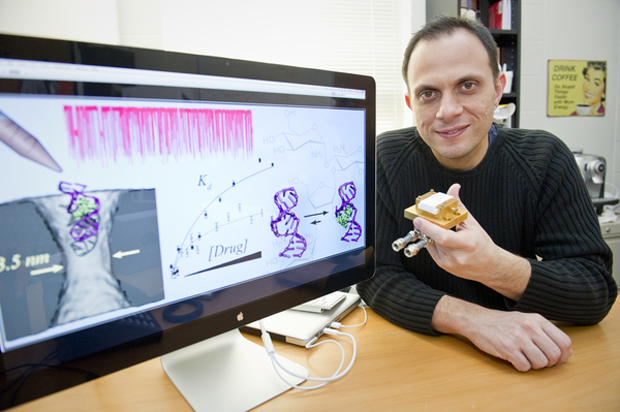Gene sequencing at warp speed

One million vocalists singing the same song will sound cacophonous to an audience member if the singers belt out the tune at different tempos.
“But if you’re listening to one person sing, and he changes his tempo, you’re still going to stay in tune with him,” said Meni Wanunu, an assistant professor of physics in Northeastern’s College of Science.
Wanunu used the analogy to explain the difference between older and newer gene sequencing techniques. Old techniques, he said, analyzed millions of DNA molecules at a time. But new techniques take a single-molecule approach, a strategy that has the potential to revolutionize the field — once a few significant challenges are overcome.
By obtaining the sequence of an organism’s genetic material with ease, scientists can explore a range of research areas, from correlating genes with functions to answering evolutionary mysteries. Doctors can use gene sequencing to test for specific genes that are related to specific diseases, such as breast and ovarian cancers. Patients could learn in their home what foods to avoid and which drugs would be most effective for them.
Older and current commercial sequencing technologies are too expensive for realizing personalized health and medicine applications. By studying DNA motion through nanopores, Wanunu’s team and others in the field hope to provide simple and straightforward approaches that could reduce sequencing costs by a thousand times, making it available for all.
In an article published on Sunday in the journal Nature Methods, Wanunu and colleagues at University of Pennsylvania and Columbia University unveiled a device that speeds up the rate at which DNA molecules can be detected, a significant step toward reading their sequence.
Wanunu, who joined the Northeastern faculty in September, designs nanoscale membranes that contain pores through which charged particles, such as DNA molecules and salt ions, can pass when exposed to an electric field.
When a long DNA molecule passes through a pore, the membrane’s current momentarily subsides, yielding a negative spike in voltage signal. DNA consists of many repeating subunits called bases, each of which has previously been shown to exhibit a characteristic signal spike.
Existing state-of-the-art techniques can’t measure current changes though a nanopore fast enough to allow reading each base. “You can show that DNA was there, but not what the sequence is,” Wanunu explained.
Slowing down DNA movement by lowering the voltage is not a practical solution, Wanunu said. “If you lower the voltage too much, at some point DNA will not want to enter and if it doesn’t enter you won’t be able to read it. If it enters too fast, you’re not going to know the sequence.”
Armed with this information, the team focused their efforts on speeding up the rate of measurement. By thinking outside the box (literally), Wanunu’s colleagues Jacob Rosenstein and Ken Shepard from Columbia University designed a miniature “patch-clamp amplifier” that is 10 times smaller than traditional amplifiers. More importantly, it is 10 times faster, being able to read current through the nanopore about every half microsecond — just about the time it takes for a DNA base to move through.
Sequencing DNA is one of many applications for this amplifier. It could also be useful for neuroscientists in reading cell currents, analyzing RNA structures and probing proteins. Wanunu plans to optimize the system, by focusing on the speed of DNA movement, on minimizing the capacity for pores to clog and on identifying stronger, thinner membrane materials like graphene.